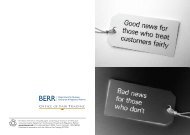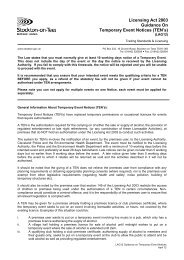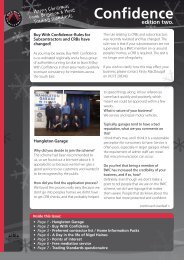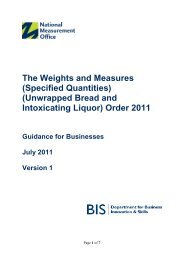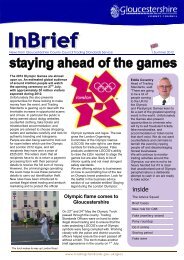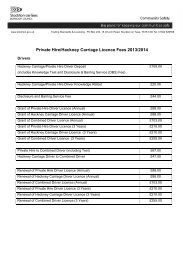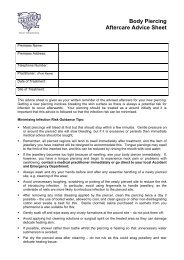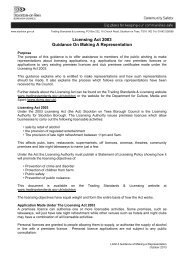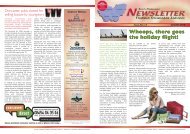View - Trading Standards Institute
View - Trading Standards Institute
View - Trading Standards Institute
Create successful ePaper yourself
Turn your PDF publications into a flip-book with our unique Google optimized e-Paper software.
GTW - Gross Train Weight<br />
Headwork - The part of the machine which incorporates the weight indications.<br />
Bottom Work - The levers and/or loadcells below the plate.<br />
Plate/Platform - The part of the machine on which the load to be weighed is placed.<br />
Double-weighing - The weighing of a load or vehicle in two or more stages. e.g. where an articulated<br />
vehicle cannot fit onto the plate its weight is calculated from the sum of the front and rear sets of axle<br />
weights.<br />
Axle weighings - The weighing of individual axles or groups of axles to determine the load placed upon<br />
them.<br />
Draw Bar Unit - A rigid vehicle towing by means of a bar a self supporting trailer.<br />
Permitted GVW) Permitted GTW) - The legal maximum weight permitted on the road.<br />
Good Weighing Practice<br />
1. Regular checks should be made to ensure that there is clearance between the plate and its<br />
surrounding frame. If the weighing machine operates using a lever bottomwork the plate should<br />
swing freely endways.<br />
2. Regular checks should be made to ensure that the weighbridge is properly balanced when<br />
unloaded and the indicator shows zero. The Weighbridge Operator must know how to balance the<br />
weighing machine.<br />
3. The balance of a weighbridge will be affected by the accumulation of dirt etc. on or around the<br />
plate. This should be regularly cleaned to avoid any excessive build-up. Beneath the plate, levers<br />
or load cells may be affected by the build-up of dirt (sand) and should be cleared as necessary. If<br />
your weighbridge is prone to such contamination a regular maintenance programme should be<br />
implemented. In a pit mounted weighbridge, balance and accuracy may be affected by a high<br />
water level in the pit which ‘floats’ the levers or the bottomwork. In such circumstances pumping<br />
facilities should be available and the Weighbridge Operator will be expected to know how to use it.<br />
The most common cause of ‘balance’ error is due to rain on the plate. During periods of rain<br />
balance should be checked and adjusted more frequently and again as the plate dries.<br />
Weighing Procedures<br />
1. It is advisable to weigh all vehicles without passengers or driver.<br />
If this is not possible or if the personnel refuse to leave the vehicle a note should be made to this<br />
effect with details of the number of persons on the vehicle. This note should be made on the<br />
ticket and on any other record. This information is required because certain persons may wish to<br />
increase the GROSS weight of the load by addition of passengers and if and when the tare<br />
weight is taken without passengers the weight of the load appears heavier. Weighbridge<br />
Operators should take special care whilst passengers are on or in the vicinity of the plate.<br />
2. Where practical the Weighbridge Operator should check the load for himself and if this is not<br />
possible the ticket should indicate the load as stated by the driver. Weighbridge Operators should<br />
be aware that persons bringing loads to be weighed may conceal heavy items amongst the stated<br />
load. This heavy article can then be discarded and the goods delivered to a purchaser. e.g.<br />
Concrete blocks with scrap metal. The load is identified as scrap metal and following weighing the<br />
concrete is discarded and the scrap metal sold at the higher weight. Therefore the weighbridge<br />
ticket would be properly completed as ‘scrap metal/concrete’.<br />
3. The Operator should always check any vehicle registration number for himself rather than rely on<br />
the driver.<br />
4. The Weighbridge Operator should have a clear view of the plate and ensure the vehicle being<br />
weighed is positioned on the plate. Weighbridge Operators should be aware that persons requiring<br />
a weighing may deliberately leave a wheel over the edge of the plate to reduce the weight shown.<br />
This is either done to reduce the tare weight (and therefore increase the apparent weight of the<br />
load or to appear below the permitted legal weights for overloading purpose.<br />
5. It is illegal to undertake a double weighing where that weighing will be used for a trade transaction.<br />
e.g. a load of hay for sale elsewhere. Drivers sometimes require a weighing to ensure they are<br />
not overloaded on individual axles It is permissible to undertake weighings of individual axles<br />
but the ticket and records should clearly indicate what type of weighing was carried out and which<br />
axles were weighed etc. The ticket should be endorsed - "Weights found are not for trade<br />
purpose".<br />
Lic 013 – Weighbridge Application<br />
Jan 11



